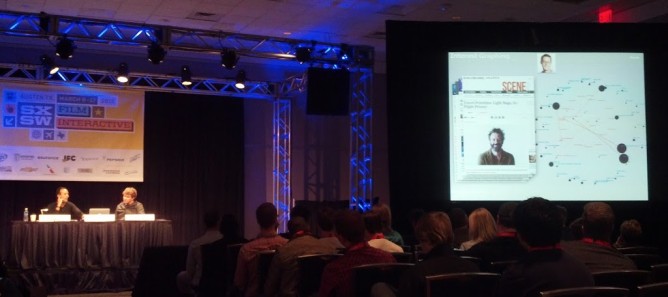A Manhattan Project of the Mind (or Brain Wars)




Cory Doctorow, author of Little Brother, Makers, and many other other awesome books, came to Portland to promote his newest book Homeland. He spoke to a standing room only crowd at Powell’s Bookstore.
He started by asking if people wanted a reading or a presentation, and everyone picked the presentation. These are my raw notes from his talk. He is a fast talker, so these notes are unfortunately incomplete (especially when it comes to the names of people he was talking about), but they should give you the gist of his talk.
He was a passionate speaker, polite to the audience during questions, and emotional when talking about Aaron Swartz’s death.
If you’ve read my blog, you know I’m a huge fan of Cory Doctorow. I’m thrilled that the sequel to Little Brother is coming out next week. It’s called Homeland, and here’s official description:
In Cory Doctorow’s wildly successful Little Brother, young Marcus Yallow was arbitrarily detained and brutalized by the government in the wake of a terrorist attack on San Francisco—an experience that led him to become a leader of the whole movement of technologically clued-in teenagers, fighting back against the tyrannical security state.
A few years later, California’s economy collapses, but Marcus’s hacktivist past lands him a job as webmaster for a crusading politician who promises reform. Soon his former nemesis Masha emerges from the political underground to gift him with a thumbdrive containing a Wikileaks-style cable-dump of hard evidence of corporate and governmental perfidy. It’s incendiary stuff—and if Masha goes missing, Marcus is supposed to release it to the world. Then Marcus sees Masha being kidnapped by the same government agents who detained and tortured Marcus years earlier.Marcus can leak the archive Masha gave him—but he can’t admit to being the leaker, because that will cost his employer the election. He’s surrounded by friends who remember what he did a few years ago and regard him as a hacker hero. He can’t even attend a demonstration without being dragged onstage and handed a mike. He’s not at all sure that just dumping the archive onto the Internet, before he’s gone through its millions of words, is the right thing to do.
Meanwhile, people are beginning to shadow him, people who look like they’re used to inflicting pain until they get the answers they want.
Fast-moving, passionate, and as current as next week, Homeland is every bit the equal of Little Brother—a paean to activism, to courage, to the drive to make the world a better place.
Go order a copy. I just did. I’ll post a review when I’ve read it.
Look out ELOPe, you’ve got competition:
In what is the largest and most significant effort to re-create the human brain to date, an international group of researchers has secured $1.6 billion to fund the incredibly ambitious Human Brain Project. For the next ten years, scientists from various disciplines will seek to understand and map the network of over a hundred billion neuronal connections that illicit emotions, volitional thought, and even consciousness itself. And to do so, the researchers will be using a progressively scaled-up multilayered simulation running on a supercomputer.And indeed, the project organizers are not thinking small. The entire team will consist of over 200 individual researchers in 80 different institutions across the globe. They’re even comparing it the Large Hadron Colllider in terms of scope and ambition, describing the Human Brain Project as “Cern for the brain.” The project, which will be based in Lausanne, Switzerland, is an initiative of the European Commission.
Read more at the Human Brain Project.
The Phoenix Project: A Novel About IT, DevOps, and Helping Your Business Win belongs to that rare category of books: a business novel. It’s written as fiction but it teaches us something serious. The most well known book in this category is The Goal: A Process of Ongoing Improvement by Dr. Eliyahu M. Goldratt. The Goal is a long-term best selling business book and required reading for nearly every MBA student for the last twenty-five years.
What The Goal did for lean manufacturing, The Phoenix Project will do for managing IT.
Bill Palmer is the reluctant protagonist who is thrust into managing IT Operations. He inherits a world of hurt: new business innovation projects are so far behind that the corporation’s ability to remain competitive is threatened; standard business functions like payroll, data storage, and point of sale systems suffer from recurrent outages like lights flickering during a storm; and the whole IT organization is so buried firefighting that critical maintenance is neglected.
I immediately resonated with the situation. In fact, if you work in a business of any size, in IT or not, you’ll quickly find similarities.
In my day job, over the years I’ve found myself wondering why small startups can outcompete two hundred person strong development teams, why certain deployments are multi-day affairs that nearly always fail, why we must wait months for to release software, why the releases that do get to the light of day are nearly always missing key features, and why we seem incapable of fixing bugs so awful that we drive our customers away.
In The Phoenix Project, the protagonist Bill Palmer encounters all of this and more. It’s written as a fast-paced business thriller (I couldn’t put it down and spent much of Christmas day hiding from my kids to read — in fact, once I hit the halfway point, I literally did not stop reading it except for bathroom breaks.) But it’s also a serious business book about managing IT.
Through an enigmatic board member, Bill is forced to question his assumptions about IT. What is the role of IT Operations, and even all of IT? What are the four kinds of work that IT must do? What’s the silent killer of all planned work? What does the business need?
Through comparisons with how work is managed in a factory and examples from The Goal, authors Gene Kim, Kevin Behr, and George Spafford show how the time tested techniques of lean manufacturing (also the Toyota Production System) apply to IT work. By applying these principles, Bill Palmer is able to:
One of the authors, Gene Kim, is the original creator of Tripwire, a widely used tool for managing IT changes; cofounder of the company by the same name; and author of The Visible Ops Handbook. I’ve seen him give talks on these concepts to a packed audience and receive a standing ovation.
For years, I’ve wanted to be able to bring these ideas back to my company because I’m convinced we could be ten or a hundred times more effective and delight our customers if only we could overcome our IT dysfunctions.
I’m thrilled to see them now in written form. If there was one book I’d want every employee of my company to read, it would be this one. You can get The Phoenix Project in kindle or hardcopy.
I read an interesting comment on a blog recently, although I can’t remember where, that made the point that as the pace of technology accelerates, we’re going through massive shifts more and more quickly, such that it becomes exceedingly difficult to predict the future beyond a certain point, and that point is coming closer and closer as time progresses.
A writer in 1850 could easily imagine out 100 years. They might not be right about what society would be like, but they could imagine. Writers in the early 1900s were imagining out about 75 years, and midcentury writers 50 years, and so on.
I’m writing now, and I enjoy the act of grounding my society in hard predictions, and it’s hard to go out beyond about 25 years because pending changing in the technology landscape are so radical (artificial intelligence, nanotechnology) that it’s really hard to conceive of what life will be like in 50 or 100 years from now, and still have it be an extrapolation of current trends, rather than just wild-ass guesses, e.g. a fantasy of the future.
If it really is harder to extrapolate trends out any sort of meaningful distance, I wonder if that exerts a subtle effect on what people choose to write.
Advertisements on apps and websites drive me crazy when they detract from using a website or application.
Earlier today, for example, I was trying to use evite to send a message to invitees to a party I held last summer. The user interface is so chock full of ads that it’s actually hard to make it from screen to screen and keep track of what I’m trying to do.
Popup ads on news sites are similarly frustrating: I want to read the content, not see a completely unrelated, intrusive ad.
I’m not opposed to paying for an ad-free experience.
I love Pandora, for example, and I’m delighted to pay for an annual subscription. I get a better product, no ads, and the feeling of supporting a company I love.
At the same time, it’s not practical to pay individually for each and every site I might visit, especially ones I use only occasionally (evite, wired.com) or once. As Chris Anderson talks about in Free, the transaction cost of paying even a small amount (the cognitive load of deciding to pay plus the mechanics of paying) vastly overwhelms the financial impact of the actual price of the product.
I think the solution is bundle or prix fixe pricing for websites.
What I imagine is something like this: As a user, I pay $X per month, or maybe $8*X per year. With this payment, I get access to a very large pool of content and websites: magazine articles, newspaper articles, and services like evite. It’s not coming from just one site or one company but from many different sites from many different companies.
When I go to sites to read, I’m identified via some common login system (like the way Facebook or Twitter authentication works). I read/use whatever I want, as much as I want. While I’m doing this, the websites are keeping track of my amount of usage, based on pageviews.
At the end of the month, the amount of my subscription is divided evenly among my pageviews. If I read one article, my $X goes to that. If I’ve read 50 articles and used 20 services, each gets 1/70th of the whole. This is done for every subscriber.
The end result is that there’s no transaction cost associated with each piece of premium content (because I’ve paid in advance), and yet there’s still a flow of dollars based on actual use. It’s a win for the customer who can now choose to conveniently get an ad-free experience without worrying about individual subscriptions, and it’s a win for web businesses, because they can now monetize their content without ads.
As a build upon the core idea, I can imagine different tiers as well:
This could also be a solution for the dilemma of newspapers: they could more effectively unlock revenue from customers in an age whether readers tend to read articles from everywhere.
Comments?